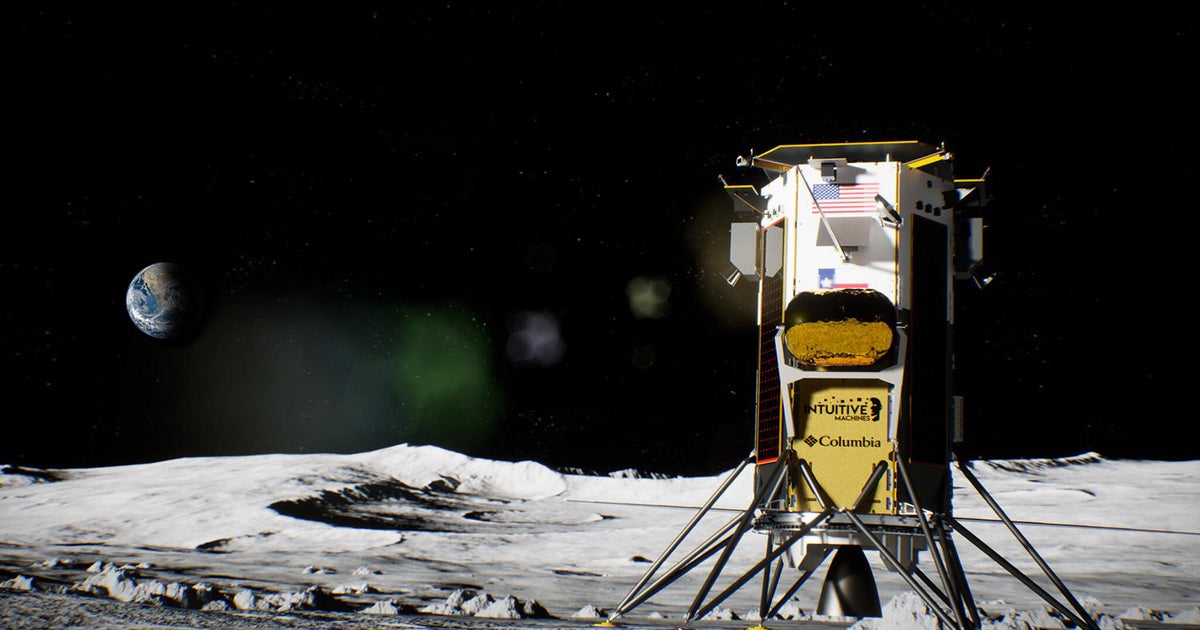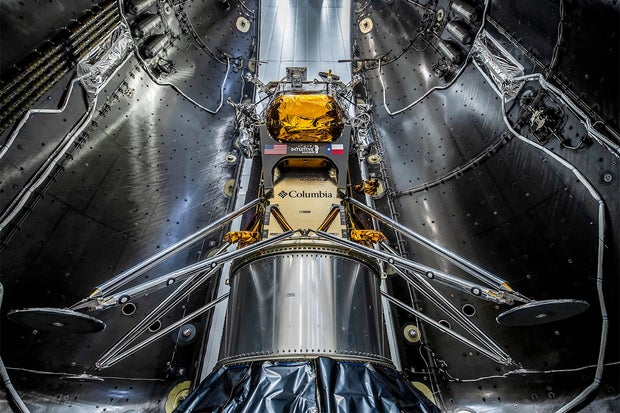CBS News
Houston company aims to return America to moon’s surface with robot lander

SpaceX readied a Falcon 9 rocket for launch early Wednesday to send a commercially built robotic lander to the moon, the first targeting touchdown near the lunar south pole where NASA’s Artemis astronauts plan to walk about in a few years.
The flight comes just five weeks after another U.S. company’s attempt to land a privately built spacecraft on the moon ended in failure, the third such commercial setback in a row.
SpaceX
The fourth such mission is set for liftoff from the Kennedy Space Center at 12:57 a.m. EST Wednesday.
If all goes well, the Odysseus lander, nicknamed “Odie,” will land Feb. 22 about 186 miles from the moon’s south pole using a high-power 3D-printed main engine burning liquid oxygen and methane propellants, a first for a deep space mission.
SpaceX carried out extensive modifications to cool and route the cryogenic propellants into the Falcon 9’s nose fairing and then into the lander’s tanks during the rocket’s countdown. Dress rehearsals were staged late last week to verify the system would work as required.
“SpaceX is tremendously proud to be part of this historic private mission to the moon,” said Bill Gerstenmaier, a former NASA manager who now works for SpaceX. “It’s not trivial to load liquid oxygen and liquid methane into the vehicle. We modified the second stage of Falcon to accommodate that. … The Falcon 9 rocket is ready to go fly.”
The flight follows the ill-fated Jan. 8 launch of another commercial moon lander — Peregrine — built by Pittsburg-based Astrobotic that suffered a propulsion system malfunction shortly after takeoff. The mishap derailed what would have been the first U.S. moon landing since the Apollo program’s final flight more than 50 years ago.
Intuitive Machines
Odysseus-builder Intuitive Machines of Houston now hopes to claim that honor.
“It is a profoundly humbling moment for all of us at Intuitive Machines,” said Trent Martin, the company’s space systems vice president. “The opportunity to return the United States to the moon for the first time since 1972 is a feat of engineering that demands a hunger to explore.”
“We’re not overlooking the challenges that lie ahead,” Martin added. “Any venture into uncharted territory carries risk, yet this willingness to embrace the risk and push beyond our comfort zones propels us forward and drives innovation. … Now let’s go make history.”
Odysseus carries six NASA instruments and another six commercial payloads, including sculptures, proof-of-concept cloud storage technology, an astronomical telescope and a student-built camera package that will drop to the surface ahead of the lander to photograph its final descent.
Among the NASA experiments is an instrument to study the charged particle environment at the moon’s surface, another that will test navigation technologies and downward-facing stereo cameras designed to photograph how the lander’s engine exhaust disrupts the soil at the landing site.
Also on board: an innovative sensor that will use radio waves to accurately determine how much cryogenic propellant is left in a tank in the weightless environment of space, technology that is expected to prove useful for downstream moon missions and other deep space voyages.
SpaceX
The Falcon 9 is expected to release the lander on a trajectory to the moon. But getting into lunar orbit and down to the surface will be up to Odysseus and the Intuitive Machines flight control team in Houston.
A key milestone is expected 18 hours after launch when the lander’s main engine is test-fired, or commissioned, to help controllers calibrate its performance in space. After that, up to three trajectory correction maneuvers are planned to fine-tune its course to the moon.
It will take Odysseus eight days to reach its target. Flying behind the moon and out of contact with flight controllers, the lander’s main engine will have to fire for seven minutes “in the blind” to put the craft into a 62-mile-high circular orbit carrying it over the landing site at 80 degrees south latitude.
During 12 trips around the moon, flight controllers will check out the lander’s systems before beginning the final descent to relatively flat terrain near a crater known as Malapert A. To ensure a safe landing, the main engine will have to reduce the spacecraft’s velocity by some 4,000 mph.
The descent will begin with a small rocket firing 75 minutes before touchdown to drop the low point of the orbit to an altitude of about 6 miles. The spacecraft then will coast for about an hour before the engine re-ignites to begin the powered descent to the surface.
Descending through an altitude of about 18 miles, Odysseus will flip from a horizontal to a vertical orientation, dropping at just under 4 mph. As the spacecraft drops below 100 feet, the “EagleCam” imaging system, built by students at Embry-Riddle University, will fall away and attempt to photograph the lander’s final descent from the side.
By the time Odysseus reaches 33 feet above the surface, the main engine will have throttled down to the planned landing velocity of just 2.2 mph — walking speed for senior citizens.
Intuitive Machines
Intuitive Machines says it will take flight controllers about 15 seconds to verify touchdown. Data recorded during the descent, including photos from the lander’s plume observation cameras and the deployed EagleCam, will be relayed back to Earth later.
Odysseus and its experiments are expected to operate for about a week before the sun sets at the landing site, cutting off solar power. The spacecraft is not designed to survive the extremely low temperatures of the two-week lunar night.
“Landing on the moon is really difficult to do,” said Joel Kearns, NASA’s deputy associate administrator for exploration. “I think people have seen different attempts at that over the last year, and it’s really tough. There’s no air on the moon, you can’t use parachutes, you have to use rockets (to decelerate) all the way down.”
“Intuitive Machines have picked some really innovative techniques that they’re (using) in their propulsion system,” Kearns said. “They’ve got some really neat things they’re going to demonstrate. That means they’re doing a lot of things for the first time.”
Only the U.S., Russia, China, India and Japan have successfully put landers on the surface of the moon, and Japan’s membership in that exclusive club comes with an asterisk: its “SLIM” lander tipped over on touchdown Jan. 19 and failed to achieve all of the mission’s objectives.
Three privately funded moon landers were launched between 2019 and this past January, one from an Israeli non-profit, one from a Japanese company and Astrobotic’s Peregrine. All three failed.
Peregrine and Odysseus were both funded in part by NASA’s Commercial Lunar Payload Services program, or CLPS (pronounced “clips”), designed to encourage private industry to develop transportation capabilities that NASA can then use to transport payloads to the moon.
The agency’s goal is to help kickstart the development of new technologies and to collect data that will be needed by Artemis astronauts planning to land near the moon’s south pole later this decade.
The agency spent about $108 million for its part in the Peregrine mission and another $129 million for the Odysseus instruments and transportation to the moon.
“These aren’t NASA missions, they’re commercial missions,” said Susan Lederer, CLPS project scientist at the Johnson Space Center. “These commercial companies will be bringing our instruments along for the ride, enabling our investigations by providing power, data and [communications] to us.
“With the commercial industry comes a competitive environment, which means that our investment up front ultimately gets far more for far less. So instead of one mission in a decade, it allows for more like 10 commercial missions to the moon in a decade.”
But the lower cost of CLPS mission brings with it higher risks. Lessons learned from Peregrine will be funneled into the development of the company’s next lander, scheduled for launch late this year, and other CLPS missions.
“We’ll learn from what doesn’t work, testing many technologies, conducting experiments at a lower cost and significantly faster than traditional NASA mission,” Lederer said. “This will allow us to prepare for Artemis more efficiently.”
CBS News
Open: This is “Face the Nation with Margaret Brennan,” Nov. 24, 2024

Watch CBS News
Be the first to know
Get browser notifications for breaking news, live events, and exclusive reporting.
CBS News
Popular gluten free tortilla strips recalled over possible contamination with wheat

A food company known for popular grocery store condiments has recalled a package of tortilla strips that may be contaminated with wheat, the U.S. Food and Drug Administration said Friday. The product is meant to be gluten-free.
Sugar Foods, a manufacturing and distribution corporation focused mainly on various toppings, artificial sweeteners and snacks, issued the recall for the “Santa Fe Style” version of tortilla strips sold by the brand Fresh Gourmet.
“People who have a wheat allergy or severe sensitivity to wheat run the risk of serious or life-threatening allergic reaction if they consume the product,” said Sugar Foods in an announcement posted by the FDA.
Packages of these tortilla strips with an expiration date as late as June 20, 2025, could contain undeclared wheat, meaning the allergen is not listed as an ingredient on the label. The Fresh Gourmet product is marketed as gluten-free.
Sugar Foods said a customer informed the company on Nov. 19 that packages of the tortilla strips actually contained crispy onions, another Fresh Gourmet product normally sold in a similar container. The brand’s crispy onion product does contain wheat, and that allergen is noted on the label.
U.S. Food and Drug Administration
No illnesses tied to the packaging mistake have been reported, according to the announcement from Sugar Foods. However, the company is still recalling the tortilla strips as a precaution. The contamination issue may have affected products distributed between Sept. 30 and Nov. 11 in 22 states: Arizona, California, Colorado, Florida, Georgia, Iowa, Idaho, Illinois, Indiana, Maryland, Maine, Michigan, Minnesota, North Carolina, New Jersey, Ohio, Oregon, Pennsylvania, Texas, Utah, Virginia and Washington.
Sugar Foods has advised anyone with questions about the recall to contact the company’s consumer care department by email or phone.
CBS News reached out to Sugar Foods for more information but did not receive an immediate reply.
This is the latest in a series of food product recalls affected because of contamination issues, although the others involved harmful bacteria. Some recent, high-profile incidents include an E. coli outbreak from organic carrots that killed at least one person in California, and a listeria outbreak that left an infant dead in California and nine people hospitalized across four different states, according to the Center for Disease Control and Prevention. The E. coli outbreak is linked to multiple different food brands while the listeria outbreak stemmed from a line of ready-to-eat meat and poultry products sold by Yu-Shang Foods.
CBS News
Gazan chefs cook up hope and humanity for online audience

Watch CBS News
Be the first to know
Get browser notifications for breaking news, live events, and exclusive reporting.












